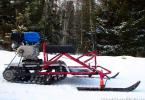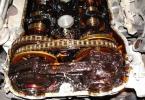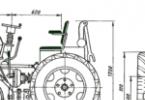The fifth generation Volkswagen Passat with the factory designation B5 was released in 1996, with its appearance the car opened a new milestone in the history of the model - it became much more technologically advanced and in its status came close to the cars of higher classes. In 1997, there were "Passats" with all drive wheels, and in 2000 the car underwent a planned modernization, as a result of which it received the index B5.5 (or B5 +). The “fifth Volkswagen Passat” marked the transition to a new design style for the brand, which was shown on the Concept One. The car can be described as follows - a large representative of the D-class, which has a somewhat contradictory appearance. "Passat" has a low and streamlined silhouette, in which the "front" part and stern are crowned with optics of modest size, which makes it look somewhat uncharacteristic.
BODY CHARACTERISTICS
The body of the car is completely galvanized, the presence of traces of rust is a sign of unqualified restoration of the car of the victim in an accident. The German concern gave a 12-year warranty for the body, which means that corrosion resistance is at its best. However, this is traditional for German cars.
WHAT'S INSIDE
The interior of the Passat of the 5th generation, including the instrument panel, covers, and everything with which the passengers directly have contact inside, is made so soundly and efficiently that the driver sometimes feels like his car is of a higher class. The gaps between the panels are minimal, the wood finish looks high quality, solid and expensive, and there are also a lot of options in the store. Thanks to the ratio of a solid interior and a large selection of additional equipment, the Passat stands out from the competition.
- The Volkswagen Passat B5 is still available in three trim levels: Trendline, Comfortline and Highline.
In the basic version of the Passat B 5 there were only 2 airbags, ABS, steering column adjustment, power steering, central locking and power accessories (mirrors and front windows). The number of options and additional equipment is simply enormous: xenon, rain and light sensors, various radio tape recorders, air conditioning or climate control, steering wheel and seat heating, leather interior, sunroof and other attributes of an expensive car.
Technical features
The B5 eventually became a real cult, many call it "the last real Volkswagen", implying that it fully meets the concept of "German quality". The owners were delighted with the quality of the interior materials, handling and engine performance, while considering the fifth Passat the standard of reliability. However, there were still some complaints, and, first of all, they concerned the chassis: the suspension did not last long on bad roads and required regular revisions.
Gasoline engines are reliable (there is only a problem with uneven idling and failure of the water pump), but the 1.9-liter turbodiesel cannot boast of durability under tough operation. Among his sores is a turbine and a tension roller that quickly breaks down, due to a malfunction of which the timing belt breaks, which leads to a major overhaul or replacement of the engine. 1.8-liter gasoline units (including the turbocharged version), in turn, are known for their large (up to 1.5 liters per 1000 km) oil consumption with mileage of more than 250 thousand km.
Mechanics consider the top-end 4.0-liter engine to be not the best choice when buying a used B5: it is difficult to repair, and he may need it only after refueling with low-quality gasoline.
As for the corrosion resistance of the body, it is extremely high - only those Tradewinds of the fifth generation that have been in serious accidents rot and rust.
In general, in the reviews on the Passat V, experts agree with the owners of these cars: this is indeed a very reliable car, problems with which begin, for the most part, only from the mark of 300 thousand km.
Specifications Volkswagen Passat B5 1.6 MT 1997 - 2000
Body
Engine
Transmission
Performance indicators
Diesel Engines
| Engine model | |||
| Engine code | |||
| Production time, from - to | |||
| Working volume, cm 3 | |||
| Power: | |||
| - kW at rpm | |||
| - l. With. at rpm | |||
| Torque, Nm at rpm | |||
| Cylinder diameter, mm | |||
| Piston stroke, mm | |||
| Compression ratio | |||
| Arrangement of cylinders and their number |
Inline, |
Inline, |
Inline, |
| Number of valves per cylinder | |||
| Engine management system 3) | |||
| Fuel, minimum CZ 4) |
|||
| Refueling volumes: | |||
|
- engine oil (with filter), l |
|||
|
- coolant, l |
|||
POSSIBLE PROBLEMS AND MALFUNCTIONS VOLKSWAGEN PASSAT B5 BU
This category includes the uneven operation of the engine at idle speed. This error can be easily treated, the reason most often lies in a clogged throttle valve. Quite often (every 45-50 thousand kilometers) the water fuel pump (pump) fails, due to poor quality antifreeze, which corrodes the pump oil seal. The most problematic point of a turbocharged 1.8-liter engine is the turbine; to extend its life, it is imperative to let the engine idle for 1-2 minutes before turning off the engine. 
As for diesel engines, many diseases of gasoline engines are not typical for them, but you cannot do without troubles. 1.9-liter turbodiesels are often spun up to high revs (contraindicated for a diesel engine) during acceleration, and this leads to faster wear of the cylinder-piston group (CPG), but still, subject to competent maintenance, they will pass 400,000 km without any problems.
To the sores of diesel engines, mechanics consider the rapid wear of the turbine, due to a violation of lubrication and the failure of the coolant temperature sensor. Often, antifreeze leaves little by little, the boost valve fails and the compression drops due to burnout of the valves. A very serious problem can be a fracture of the tension roller, which leads to a broken belt and collision of valves with pistons, and this guarantees a large investment.
Although the unit injectors have proven to be very reliable, they are still quite expensive to repair. The reason for the replacement is the terrible quality of domestic diesel fuel with a high sulfur and paraffin content.
Gearboxes are a priori reliable, but subject to timely oil change and maintenance.
- From the factory, the cars were equipped with a five-speed mechanics, to which a 6-speed manual was added after restyling. There are no complaints about both boxes, only the replacement of the clutch disc at the turn of 200,000 km. Over time, there is a slight backlash when shifting gears, but this does not create problems.
- With regard to the automatic transmission. Until 1999, a 4-speed automatic was installed on the Passat B5, later it was replaced by an automatic transmission with 5 steps and a tiptronic manual shift function. In general, automatic transmissions are very reliable and do not bother the owners, but all this is true only on condition of timely qualified service. An oil change is recommended every 60,000 kilometers.
Safety
The Passat B5 is not among the safest cars: in 1997 it earned only three stars out of five in EuroNCAP crash tests. Moreover, with a side impact, the mannequins suffered less than with a frontal impact. As for the safety of pedestrians, in this discipline the fifth Passat could not meet even the minimum requirements of EuroNCAP.
In 1999, Volkswagen China introduced a lengthened version of the fifth Passat, which was later renamed and launched in Europe as the Skoda Superb. 
The B5's suspension was tweaked seven times to strengthen it, but the chassis was still a headache for the fifth-generation Passat owners.
In 2005, the British magazine Top Gear named the Passat B5 one of the worst family cars, worse than which, according to journalists, were only the Fiat Marea and the Rover 45.
Competitors
The main competitors of the fifth Passat are the Opel Vectra, Citroen C5, Peugeot 406 and the third generation Ford Mondeo, that is, the most popular cars in the category of mid-size family cars. All of them offered approximately the same level of comfort and equipment, were quite reliable, therefore, it is possible to name an unambiguous leader from this five only in Russia, where the fifth Passat confidently bypassed all its competitors.
PRICES FOR SPARE PARTS FOR VOLKSWAGEN PASSAT B5 WITH MILEAGE
Although the creators position the car as a popular car, prices for auto parts are often far from democratic. But this was to be expected, since the car is quite complex in technical terms. For example, chassis parts, various sensors responsible for the operation and control of the engine, fuses can be unpleasantly surprised by their cost. The only consolation is that the Passat bu is a very common car, so there will be no problems with original parts. In the worst case, it is possible to buy a used part for disassembly, and this applies not only to such frequently required parts as the hood and bumper, but also to the technical filling. Also in online stores you can order original and non-original stock for Volkswagen Passat B5. Another plus is that the car is well known to the craftsmen, so there are usually no problems with the provision of high-quality repairs.
Figures and awards
The fifth generation Passat was treated kindly by the specialized press, in just two years (1998 and 1999) it received four awards at once. It was named Best Family Car by Used Car Buyer, Auto Express and Which Magazine and What Car?
In 2000 and 2001, the B5 won two more Auto Express Family Car awards, as well as Diesel Car and Used Car Buyer and Auto Express titles.
In nine years, 485,797 B5 Tradewinds were produced for the Canadian and US markets.
Volkswagen Passat B5 test drive and review. Passat B5.
The fifth generation Volkswagen Passat with the factory designation B5 was released in 1996, with its appearance the car opened a new milestone in the history of the model - it became much more technologically advanced and in its status came close to the cars of higher classes. In 1997, there were "Passats" with all drive wheels, and in 2000 the car underwent a planned modernization, as a result of which it received the index B5.5 (or B5 +).
The “fifth Volkswagen Passat” marked the transition to a new design style for the brand, which was shown on the Concept One. The car can be described as follows - a large representative of the D-class, which has a somewhat contradictory appearance. "Passat" has a low and streamlined silhouette, in which the "front" part and stern are crowned with optics of modest size, which makes it look somewhat uncharacteristic.
This "German" was offered in two body modifications - sedan and station wagon (Variant). The car is 4669-4704 mm long, its width does not exceed 1740 mm, and its height is 1460-1499 mm. The distance between the axles is unchanged in all cases - 2703 mm, but the ground clearance varies from 110 to 124 mm.

The interior of the Volkswagen Passat B5 is monumental and "thoroughbred" in appearance. The instrument panel is represented by two large dials, between which the information display of the trip computer is located. The steering wheel is endowed with a 3-spoke design with a large brand emblem, and the massive center console has sheltered the climate control unit, radio and auxiliary buttons.

The interior of the German D-model is finished with high-quality materials, namely, pleasant and soft plastics, decorative wood-like inlays and good-quality leather in which the seats are dressed.
The front of the "fifth" VW Passat has wide seats with an optimal profile and decent adjustment ranges that will be comfortable for riders of any body type. The back sofa with soft filling provides ample space for three passengers on all fronts.
The luggage compartment of the three-volume Passat B5 is designed to carry 475 liters of luggage, with the back of the second row of seats folded down - 745 liters. The “hold” capacity of the cargo-passenger model is 495 liters, and its maximum capacity is fixed at 1200 liters.
Specifications. One of six petrol engines can be found under the hood of the fifth generation Volkswagen Passat.
The range of "fours" consists of naturally aspirated and turbocharged engines with a volume of 1.6-2.0 liters, which generate from 101 to 150 horsepower and from 140 to 220 Nm of torque. A V-shaped five-cylinder 2.3-liter unit was also offered for the car, the potential of which has 150 "horses" and 205 Nm of maximum torque. The 2.8-liter V6 is assigned to the role of the "top-end", developing at peak 193 power forces and 290 Nm of torque.
The four-cylinder diesel turbo engine with a volume of 1.9 liters, depending on the level of boost, produces 90-115 horsepower and 210-285 Newton meters. There was also a 2.5-liter V-shaped "six" with a capacity of 150 "mares" and 310 Nm of torque.
Engines were combined with a 5 or 6-speed manual gearbox and a 5-speed automatic gearbox, by default the car was equipped with a front-wheel drive transmission, 4Motion all-wheel drive technology was optionally available. Depending on the modification, up to the first 100 km / h "Passat" of the fifth generation rushes in 7.6-15 seconds, and the possible speed is fixed at 177-238 km / h.
The Volkswagen Passat B5 is based on the PL45 bogie with a longitudinal power unit. The front suspension is a double wishbone design, the rear suspension is a semi-independent design with a torsion beam on front-wheel drive vehicles and an independent "multi-link" with all-wheel drive. The steering system has a built-in power steering, and the brake package consists of fully disc brakes (front - with ventilation).
The owners describe it as a nice car with a spacious interior and reliable construction, which costs an adequate amount of maintenance. In addition, VW Passat B5 has a huge "hold" for luggage, acceptable fuel consumption, high-quality sound insulation and good finishing materials.
The overall picture is spoiled by the suspension, which is rigid for Russian roads, "capricious" electronics, and a modest clearance to the roadway.
Prices. In the secondary market of Russia "Passat" of the fifth generation in 2015 can be found at prices ranging from 180,000 to 300,000 rubles.
Ground clearance Volkswagen Passat or clearance like for any other passenger car is an important factor on our roads. It is the condition of the road surface or its complete absence that makes Russian motorists interested in the clearance of the Volkswagen Passat and the possibility of increasing ground clearance using spacers.
To begin with, it's worth honestly saying that real clearance Volkswagen Passat may seriously differ from that declared by the manufacturer. The whole secret is in the method of measurement and the place of measurement of the ground clearance. Therefore, you can find out the real state of affairs only by yourself armed with a tape measure or a ruler. Official ground clearance Volkswagen Passat different generations differ significantly.
- Ground clearance Volkswagen Passat B8 from 2014 onwards - 160 mm (in the EU 145 mm)
- Ground clearance Volkswagen Passat B7 since 2010 - 155 mm (in the EU 135 mm)
- Ground clearance Volkswagen Passat B6 since 2005 - 163 mm (in the EU 139 mm)
On some modifications (depending on the type of body / power unit / transmission), the clearance may differ.
Some manufacturers go for the trick and declare the size of the ground clearance in an "empty" car, but in real life we have a full trunk of all sorts of things, passengers and a driver. That is, in a loaded car, the clearance will be completely different. Another factor that few people have in mind is the age of the car and the wear and tear of the springs, their "subsidence" from old age. The issue is solved by installing new springs or buying spacers under sagging springs Volkswagen Passat... The spacers allow you to compensate for the spring sag and add a couple of centimeters of ground clearance. Sometimes even a centimeter in the parking lot at the curb plays an important role.
But do not get carried away with the "lift" of the Volkswagen Passat's ground clearance, because the spacers to increase the clearance are focused only on the springs. If you do not pay attention to the shock absorbers, the travel of which is often very limited, then self-modernization of the suspension can lead to loss of control and damage to the shock absorbers. In terms of cross-country ability, high ground clearance in our harsh conditions is good, but at high speeds on the track and in corners, there is a serious buildup and additional body roll.
A detailed video of installing spacers to increase ground clearance on the Volkswagen Passat.
When designing a suspension and choosing the amount of ground clearance, any car manufacturer is looking for a middle ground between handling and cross-country ability. Perhaps the easiest, safest and most unpretentious way to increase clearance is to install wheels with “high” tires. Changing wheels makes it easy to increase the ground clearance by another centimeter.
Do not forget that a serious change in ground clearance can damage the CV joints of the Volkswagen Passat. After all, "grenades" will have to work from a slightly different angle. But this only applies to the front axle. Moreover, a serious change in ground clearance can lead to uneven rubber wear.
We've covered how to choose the polyurethane spacers, as well as the springs and dampers needed to increase the ride height. In this article, we will talk about two important points regarding the increase in ground clearance - the possibility of self-installation of spacers, springs and shock absorbers, as well as the need to repair the suspension before increasing the ground clearance.
Do I need to repair the suspension before increasing ground clearance
Many workshops that increase ride height offer their customers complete suspension repairs. The cost of such repairs is comparable to all the costs of increasing ground clearance, so not everyone agrees to such an offer, perceiving it as an attempt to impose an unnecessary service. But is she really not needed? To answer this question, you need to understand what happens to the suspension after the ride height is increased. Usually, the clearance is increased in order to drive on bad roads without damage. Indeed, in terms of comfort, the Volkswagen Passat is noticeably superior to such cars as the UAZ or Niva, although it is inferior to them in cross-country ability. When a car with a suspension tuned for good roads is driven off-road or bumpy roads, the suspension is subjected to very heavy loads. When driving on a good road, the amplitude of the vertical movement of the unsprung mass is small, because small irregularities in asphalt or concrete are not able to create a sufficiently powerful impulse. Because of this, the load on the shock absorbers and suspension bushings is minimal.
When the car moves off-road, the situation changes dramatically. On off-road or bumpy roads, the amplitude of movement of the unsprung mass is ten times greater. After all, it is one thing to successfully resist the inertia of an unsprung mass, and quite another thing to push the road. Due to the large height difference on the road and the associated large travel of the unsprung mass relative to the body, the pressure on the silent blocks increases sharply. After all, the suspension is a triangle with two static vertices that cannot change their position. The first peak is the junction of the body and the support bearing or spring, and the second peak is the silent blocks connecting the suspension arms to the body. The suspension of the Volkswagen Passat is tuned for good roads, therefore, it is quite stiff. On the track, this is an undoubted advantage, because it improves the handling and stability of the car. But off-road, this turns into a huge minus, because a too stiff suspension does not have enough travel to effectively dampen the huge vertical amplitude of wheel motion. Consequently, the energy that could not be stretched in time with the help of the spring will shock the silent blocks. This explains the short service life of the suspension of foreign cars on Russian roads.
The increase in ground clearance often instills in the owners of foreign cars unreasonable confidence in the high all-terrain qualities of their car. And they sweep along the broken sections of the road like Russian Volga, Ladas or Muscovites. But the suspension of domestic cars is much better adapted for our roads, therefore, the load on the silent blocks there is much less due to the lower stiffness of the springs and shock absorbers. Therefore, even small, barely noticeable damage to the silent blocks, during fast driving on bumpy roads, can quickly turn into full-fledged breaks. Moreover, the rupture of an entire silent block occurs several times slower than even a slightly damaged one. All this allows us to conclude that repairing the suspension before increasing the ground clearance is not a whim of car service workers and not a desire to impose an unnecessary service, but a very necessary event that will seriously extend the service life of silent blocks. And broken silent blocks, this is a decrease in controllability, loss of stability in corners, accelerated tire wear and other unpleasant manifestations.
Is it possible to increase the clearance yourself
Despite the fact that the cost of installing spacers or a package of bad roads in the workshop is not high, many Volkswagen Passat owners are wondering if it is possible to do this work yourself? Theoretically, there is nothing complicated in this work, and a description of the process can be found both on the website and in other sources. If you can repair the suspension yourself and have all the tools you need, then you can easily cope with installing new springs and shock absorbers or spacers. If you do not possess such skills, then there is a high probability that you will make a mistake that will negatively affect some of the characteristics of the car. In one of the subsequent articles, we will tell you about such errors and give recommendations on how to avoid them.



